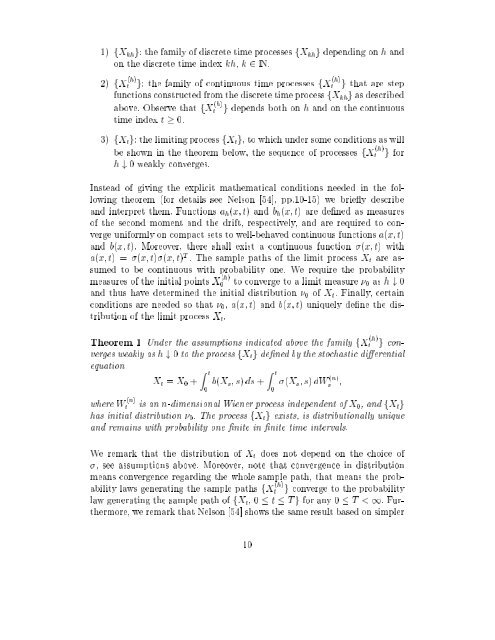Estimation in Financial Models - RiskLab
Estimation in Financial Models - RiskLab
Estimation in Financial Models - RiskLab
Create successful ePaper yourself
Turn your PDF publications into a flip-book with our unique Google optimized e-Paper software.
1) fX kh g: the family of discrete time processes fX kh g depend<strong>in</strong>g on h and<br />
on the discrete time <strong>in</strong>dex kh, k 2 IN.<br />
2) fX (h)<br />
t g: the family of cont<strong>in</strong>uous time processes fX (h)<br />
t g that are step<br />
functions constructed from the discrete time process fX kh g as described<br />
above. Observe that fX (h)<br />
t g depends both on h and on the cont<strong>in</strong>uous<br />
time <strong>in</strong>dex t 0.<br />
3) fX t g: the limit<strong>in</strong>g process fX t g, to which under some conditions as will<br />
be shown <strong>in</strong> the theorem below, the sequence of processes fX (h)<br />
t g for<br />
h # 0weakly converges.<br />
Instead of giv<strong>in</strong>g the explicit mathematical conditions needed <strong>in</strong> the follow<strong>in</strong>g<br />
theorem (for details see Nelson [54], pp.10-15) we briey describe<br />
and <strong>in</strong>terpret them. Functions a h (x; t) and b h (x; t) are dened as measures<br />
of the second moment and the drift, respectively, and are required to converge<br />
uniformly on compact sets to well-behaved cont<strong>in</strong>uous functions a(x; t)<br />
and b(x; t). Moreover, there shall exist a cont<strong>in</strong>uous function (x; t) with<br />
a(x; t) = (x; t)(x; t) T . The sample paths of the limit process X t are assumed<br />
to be cont<strong>in</strong>uous with probability one. We require the probability<br />
measures of the <strong>in</strong>itial po<strong>in</strong>ts X (h)<br />
0 to converge to a limit measure 0 as h # 0<br />
and thus have determ<strong>in</strong>ed the <strong>in</strong>itial distribution 0 of X t . F<strong>in</strong>ally, certa<strong>in</strong><br />
conditions are needed so that 0 , a(x; t) and b(x; t) uniquely dene the distribution<br />
of the limit process X t .<br />
Theorem 1 Under the assumptions <strong>in</strong>dicated above the family fX (h)<br />
t g converges<br />
weakly as h # 0 to the process fX t g dened by the stochastic dierential<br />
equation<br />
X t = X 0 +<br />
Z t<br />
0<br />
b(X s ;s) ds +<br />
Z t<br />
0<br />
(X s ;s) dW (n)<br />
s ;<br />
where W (n)<br />
t is an n-dimensional Wiener process <strong>in</strong>dependent of X 0 , and fX t g<br />
has <strong>in</strong>itial distribution 0 . The process fX t g exists, is distributionally unique<br />
and rema<strong>in</strong>s with probability one nite <strong>in</strong> nite time <strong>in</strong>tervals.<br />
We remark that the distribution of X t does not depend on the choice of<br />
, see assumptions above. Moreover, note that convergence <strong>in</strong> distribution<br />
means convergence regard<strong>in</strong>g the whole sample path, that means the probability<br />
laws generat<strong>in</strong>g the sample paths fX (h)<br />
t g converge to the probability<br />
law generat<strong>in</strong>g the sample path of fX t ,0 t T g for any 0 T < 1. Furthermore,<br />
we remark that Nelson [54] shows the same result based on simpler<br />
10
















